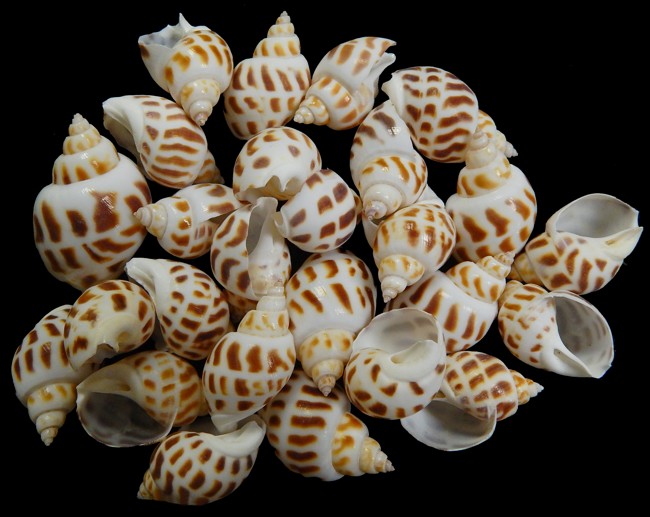As the site is updated, each listing includes the shipping cost. Some listings which I have not updated still give you calculated shipping costs based on weight and size of package. (In the sections I have updated) If you select several different listings, we will consolidate your order and charge you the actual cost of the entire package. The shipping over charge will be refunded to you, when your order is shipped.
BABYLON SHELLS ARE A SMALL GROUP OF GASTROPODS FROM THE TROPICS
Babylonia is a genus of sea snails, marine gastropod mollusks in the family Babyloniidae.
The Babyloniidae are predators the common snail is their prey. The Babylon species breaks their shells and eats them.
Babylon Shells have a thick glossy outside shell, often plump looking with brown spots or swirls covering the whorl (outside body). They primary inhabit the tropical Pacific in the Indo_Pacific region stretching from Eastern Indian Ocean east to the Northern shores of Australia and New Zealand. They prefer shallow sandy or muddy sea water.
(REF: Babylonia Schlüter, 1838. Retrieved through: World Register of Marine Species)
Scientific classification
Domain: Eukaryota
Kingdom: Animalia
Phylum: Mollusca
Class: Gastropoda
Subclass: Caenogastropoda
Order: Neogastropoda
Family: Babyloniidae
Kuroda, T.
T. Habe
K. Oyama, 1971

Babylonia Spirata, common name the Spiral Babylon
Babylonia Spirata is a species of sea snail, a marine gastropod mollusk, in the family Babyloniidae. They belong to the genus Babylonia.
Babylonia Spiratas have a thick shell, having an almost flush sided body whorl (outside shell around its imaginary axis). A spire seems pushed down Into the body, separated by a deep channel wrapping around the body whorl. The shell has rings of brown and alternating cream color spiralling around the body. The Spirata Babylon is common across the Indian Ocean and has been seen east thru the Indo-Pacific region.
They like a muddy sea floor with coarse sand.
Spirata Babylons are carnivorous, preferring to feed on clam meat.
The Spirata Babylon grows to an length of about 1 1/2 inches.
The shell of B. spirata shows a characteristic color pattern consisting of regular spiral rows of round bright brownish patches on a white background. The apex of the shell the oldest part, showed a reverse coiling. The umbilicus was found to be either closed or open. It has a smooth surface. Its apex (spire) is well elevated with a conical shape and the flatted whorls are inflated. The shell consists of six or seven whorls lying very close to each other.
Scientific classification
Domain: Eukaryota
Kingdom: Animalia
Phylum: Mollusca
Class: Gastropoda
Subclass: Caenogastropoda
Order: Neogastropoda
Family: Babyloniidae
Genus: Babylonia
Species: B. spirata
Binomial name: Babylonia spirata
(Linnaeus, 1758)
(REF: Mollusca Base (2018). Babylonia spirata (Linnaeus, 1758). Accessed through: World Register of Marine Species) (REF: MolluscaBase eds. (2021). MolluscaBase. Babylonia Schlüter, 1838. Accessed through: World Register of Marine Species )
C1C2-8
One quarter pound of Spirata Babylon shells, measuring between 1 and 2 inches....... $6.95

Babylonia Japonica, common name the Japanese Babylon or Japanese ivory shell
Babylon Japonica is a species of sea snail, a marine gastropod mollusk in the family Babyloniidae.These sea snails can be found along the coasts of Korea, Japan and Taiwan.
The ground color of the shell is white. The outer whorl has two rows of brown blotches among rows of fine spots. The average length of the shell varies between 1 1/2 and 3 1/2 inches.
The ground color of the shell is white. The outer whorl has two rows of brown blotches among rows of fine spots.The Babylon Japonica shell in life is covered by a brown or tan periostracum.
The periostracum is a thin, organic coating (or "skin") that is the outermost layer of the shell of many shelled animals, including mollusks and brachiopods. Among mollusks, it is primarily seen in snails and clams, i.e. in gastropods and bivalves, but it is also found in cephalopods such as Allonautilus scrobiculatus. The periostracum is an integral part of the shell, and it forms as the shell forms, along with the other shell layers. The periostracum is used to protect the organism from corrosion.
Scientific classification
Domain: Eukaryota
Kingdom: Animalia
Phylum: Mollusca
Class: Gastropoda
Subclass: Caenogastropoda
Order: Neogastropoda
Family: Babyloniidae
Genus: Babylonia
Species: B. japonica
Binomial name: Babylonia japonica
(Reeve, 1842)
(REF: Babylonia japonica (Reeve, 1842). Retrieved through: World Register of Marine Species )
(REF: "periostracum". Dictionary.com Unabridged) (REF: Pfenninger M.; Hrabáková M.; Steinke D.; Dèpraz A. (2005). "Why do snails have hairs? A Bayesian inference of character evolution")
F1F2-8
Six hand-selected Babylonia Japonica shells, measuring 1 to 2 inches....... $6.75

Babylonia areolata
Babylonia Areolata is a species of snails in the family Babyloniidae. Individuals can grow to 2 1/2 inches.
The Babylonia Areolata shell relatively thin, ovate & light. The spire is tall, apex pointed, whorls rounded. Suture channeled. Its edge is rounded at shoulder with a Wide umbilicus. The shell has a Thin inner lip. The shell color has spiral bands of rectangular brown patches on white.
Babylonia Areolatas have been found in waters as deep as 33 feet. This species pefers sandy bottom topical seas. They range across the Indo-Pacific region; where they are an important food. This has resulted in over fishing with a drastic reduction of population across the Indo- Pacific. To satisfy the demand for this species aquafarming has developed across the Indo-Pacific region, especially in China.
Scientific classification
Domain: Eukaryota
Kingdom: Animalia
Phylum: Mollusca
Class: Gastropoda
Subclass: Caenogastropoda
Order: Neogastropoda
Family: Babylonidae
Genus: Babylonia
Species: B. areolata
Binomial name: Babylonia areolata
(Link, 1807)
(REF: Bouchet, P. (2015). Babylonia areolata (Link, 1807). In: MolluscaBase (2015). Accessed through: World Register of Marine Species) (REF: Tadashige Habe & Sadao Kosuge (1965) Babylonia areolata In: Shells of the World in Colour Vol.II The Tropical Pacific. Hoikusha)
(REF:Biochemical Systematics and Ecology Volume 38, Issue 6, December 2010 )
(REF: 2019, Songklanakarin Journal of Science and Technology)
BO-8
Six hand-selected Babylonia Areolata shells measuring 1 to 1.5 inches...... $6.75